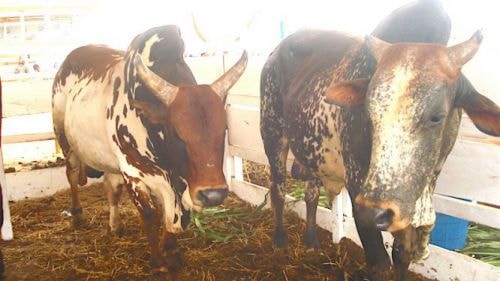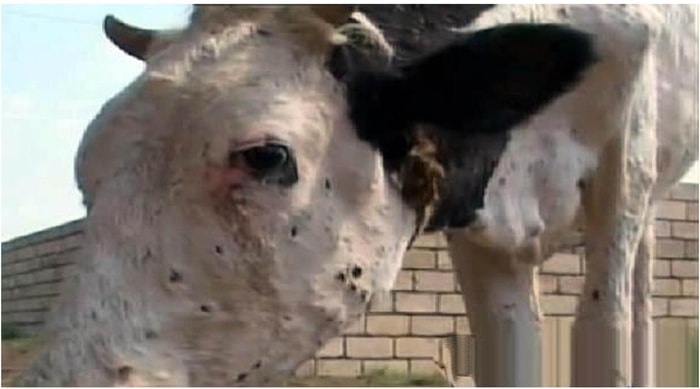Cow poxs is a mild viral disease of cattle, buffaloes, and camels characterized by typical pox lesions on the teats, udder, and skin. The disease, also called vaccinia, an eruptive disease transmitted to a healthy human, produces immunity for the smallpox virus. The cowpox virus is very closely related to the variola virus, the causative organism of smallpox in human beings.
Essential information of Cow Poxs
Cowpox is a rare disease of cattle that causes pocks like lesions on the teats and udder. The disease is spread to humans by direct contact with affected cattle. Cattle and buffaloes are not the primary hosts; instead, rodents act as reservoirs and primary hosts of the virus. Domestic cats also act as a reservoir of the cowpox virus. Young people are affected mainly by the cowpox virus as they come into contact with domestic cats. The virus is self-limiting and produced immunity against the smallpox virus.

Epidemiology and Transmission of Cow Poxs
The disease has been reported in South Asian countries, Africa, and European countries. Young animals are mostly affected than adult ones. The disease is usually spread by direct contact or by intradermal injection. The cow poxs infection has zoonotic importance since the lesions can be seen in the wrist, hands, and thumbs of human beings. In addition, there may be the presence of mild fever with involvement of regional lymph nodes. The infection has customarily been seen pick during milking and handling of sick animals. The morbidity of the cowpox virus may reach up to 70%, and mortality is comparatively low in cattle and buffaloes.
Causes of Cow Poxs Infection
The Cowpox virus causes the disease under the genus Orthomixovirus belongs to the family Poxviridae. The virus typically affects cattle, buffaloes, camels, rodents, elephants, cats, and swine. In addition, the virus affects human beings by direct contact with the affected animals.

Clinical Signs and Symptoms of Cow Pox
The most commonly seen clinical signs and symptoms of the cowpox virus in cattle and buffaloes are:
- The affected animals reveal fever, anorexia, dullness, depression, and congestion of the conjunctiva.
- The lesions are noticed either in localized form or in generalized form.
- In localization form, animals show typical pock lesions involving mainly the thigh’s teats, udder, and medial aspects.
- In generalized form, these are seen on various parts of the body, including the lips and around the eyes.
- In young animals that suckle infected udder, purulent gingivitis may also be developed.
Diagnosis of Cow Poxs Infection
The presumptive and confirmatory diagnostic procedures of the disease are:
- The disease can be diagnosed primarily by clinical signs and can be confirmed by isolating the virus from lesions present on teats or udder.
- It can also be confirmed by precipitation test, compliment fiction test, or virus neutralization test.
- ELISA has been found more sensitive to confirm the disease.
Differential Diagnosis of Cowpox Infection
The disease should be differentiated from:
- Foot and Mouth Disease (FMD).
- Pseudo Cow Pox infection.
- Udder Impetigo in cattle.
Treatment of Cow Pox Infection
The disease is primarily self-limiting and cured without any treatment.
- There is no specific treatment as the virus causes the disease.
- However, to prevent secondary bacterial infection, antibiotic therapy with a broad-spectrum antibiotic should be administered as early as possible of the disease.
- Care must be taken to restrict the occurrence of mastitis in the affected cows.
Prevention and Control of the Disease
The usual preventive measures of the disease are as follows:
- A suitable vaccine is available against cow and buffalo pox infections, so adopting strict hygienic measures can only control the disease.
- The human beings handling the infected animals must adequately clean their hands with quaternary ammonium compound or other strong disinfectants.
Concluding Remarks on Cow Poxs Infection
Cow poxs infection is not a typical virus disease in cattle and buffaloes. However, the disease is seen sporadically in United Kingdom, Asia, and African countries. In addition, the disease has a great significance in developing vaccines against the smallpox virus in humans. The smallpox virus is now eradicated from the world, but cowpox still exists. In my article, I have briefly discussed the most crucial information about the disease for veterinarians and farm owners.